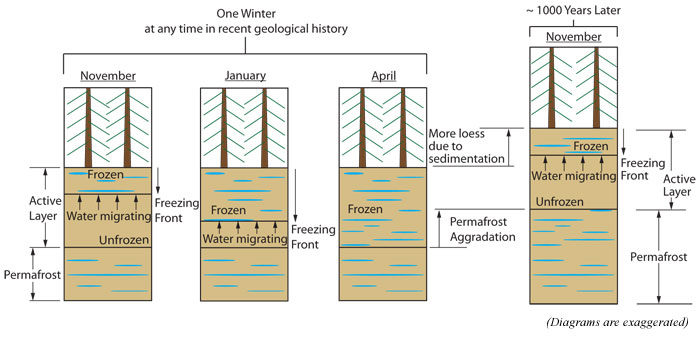When examining permafrost within a centimeter scale, the matrix of soil and ice can be described as textures or cryostructures. The combination of various cryostructures and how they layer on top of each other makes up the cryostratigraphy. Then the study of the cryostructures with the frozen ground's formation and structure is cryolithology. And finally, cryolithology is a branch of geocryology which is the study of geological materials that are below 32°F.
Cryostructures are predominately determined by the types of segregated ice within the soil, which forms as the ground freezes. Through out the winter, the ground freezes from the surface downwards, causing a freezing front to move from the surface downwards as seen in the one winter portion of the diagram. In fine-grained soils, available water within the soil is attracted to the freezing front by capillary action and other forces. This water freezes and forms ice lens, which is seen in blue in the diagram. The lateral extent of an ice lens is dependent on the amount of water available and exploitation along the bedding planes. This process causes volume expansion within soil columns and the ground surface to rise upwards, and is known as frost heaving.
In permafrost areas, the segregated ice forms each winter in the top active layer. Then the following summer, the entire active layer along with segregated ice will generally thaw during the summer or occasionally a small layer at the bottom of the active layer will remain frozen and become captured within the permafrost. The capturing can be caused by periods of colder climates, such as ice ages, or as a part of syngenetic permafrost growth as seen in the diagram below. Over the decades, silt is slowly deposited and raised the surface elevation. If the thickness of the active layer remains approximately the same, the top of the permafrost will rise in elevation and captures the bottom of the active layer. As variations in climate and the local ecosystem happen throughout the decades, some evidence can be captured within permafrost with variations in cryostructures and organic inclusions.
 Diagram of segregated formation.
Diagram of segregated formation.